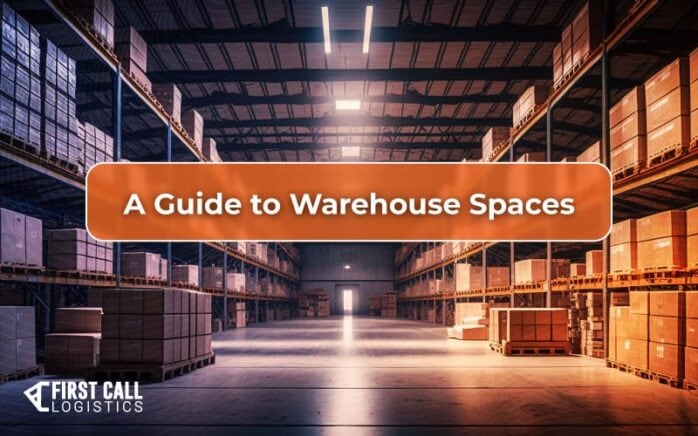A Guide to Warehouse Spaces

Ask a dozen logisticians the optimal way to manage warehouse spaces and you’re likely to get a dozen different answers — but ask them whether or not warehouses need space management systems, and the answer would be a unified and resounding “Yes.”
Here’s a few tips for businesses looking to establish safe and efficient warehouse operations:
What Makes a Good Warehouse Storage System?
A good warehouse storage system makes the most of your business’ available storage space while keeping items accurately logged and easily retrievable (nobody wants to dig through pallets to find a single item buried deep in a 40,000-sqft. warehouse). A great warehouse storage system will do all that, plus protect the safety of warehouse workers by keeping inventory secure and the warehouse clean (no slips, spills or toppling towers of products).
More than 2.6 million non-fatal work-related injuries were reported in 2021, with an additional 5,200 cases resulting in a fatality. Of those cases, slips, trips and falls marked the second-fastest growing category with a 5.6% increase in incidents compared to the previous year. Successful warehouse storage systems keep inventory safe, keeps walkways clear and lowers the chances of operational injuries — an obvious benefit for your workers and company inventory at large.
Keeping inventory organized also raises the cleanliness factor of your entire warehouse, preventing pests from infiltrating your warehouse without your knowledge. You can find more detailed info on warehouse pest problems here.
Five Common Warehouse Storage Systems
There are several ways to manage a warehouse, and each with its own merits. Based on the design and structure of the warehouse, some solutions may be more suitable (and affordable) than others. Here are five commonly-used storage systems you’ll likely encounter when determining optimal warehouse management:
- Pallet racks. Made from wood, metal or heavy-duty plastics, pallet racks are designed to hold entire pallets (or large boxes) of inventory. They can be quite tall, leading most warehouses employing this system to use forklifts or other machinery to manage the storage and retrieval process.
- Multi-tier racks. This describes several vertical levels of shelving which warehouse team members can then access via stairs for manual loading. It’s best for managing relatively small, lightweight items (because…stairs). Warehouses with more vertical space than floor space tend to favor this storage system.
- Static or permanent shelving. Shelves that are often built-in and thus occupy a permanent spot in the warehouse (ie. no rearranging the shelving layout). Though they are built to handle several hundred pounds, they are generally not equipped to handle loads you’d need a forklift to raise and store. Inventory stored here is usually picked, prepped, and packed by hand.
- Mobile shelving. Shelves utilizing mobile bases installed directly in warehouse floors to allow for lateral sliding. This nifty storage option enables a warehouse to save space by grouping multiple shelves right next to each other, allowing enough space for just one aisle. Accessing a specific product is achieved by simply sliding the appropriate shelves away to pick the selected item.
- Mezzanine flooring. An elevated platform placed between the floor and ceiling to increase the storage and working space available in the warehouse. Flooring customization is possible; often businesses will add lights, conveyor belts and other systems as needed. As this is an additional build inside of the warehouse, installation can be expensive — but it can be worth it in the long run compared to investing in a second building.
Using Software to Improve Storage Systems
Warehouse Management Software (WMS) improves warehouse functionality in virtually every way. WMS can track receipts and orders, help manage inventory levels and give visibility into your storage management through one intuitive digital platform. When used correctly, WMS has the power to refine and improve the processes brands already have in place and help decentralize warehousing to further protect your supply chain. It can also improve overall picking and packing speed and accuracy.
Using a WMS, you’ll also be able to pull reports on important warehouse metrics to continually track and refine your inventory management (meaning faster shipping and happier customers).
Why Our Partners Utilize FCL Warehousing
Not every company can afford to invest in a WMS to manage their warehouse spaces, which is why partnering with a 3PL who’s already implemented the software can be so beneficial.
First Call uses advanced warehouse and transportation management systems to carefully track the location and status of every single item that comes through our in-house facilities. Each of our partners receive a login to a secure customer portal where they can access real-time inventory location and shipment status updates at any time.
First Call currently offers three strategically located warehouses in Indianapolis, Louisville and Irving, TX, along with an established nationwide carrier network to transport inventory safely to customers.
Learn more about our Warehousing & Distribution Services, and be sure to keep First Call in mind as you seek a more resilient supply chain.
Streamline Delivery with Flexible Storage Solutions
Speedy delivery is crucial to any growing business. First Call’s Warehousing & Distribution Services can help establish resilient supply chains, deliver products on time and achieve long-term business goals.
More Resources on Warehousing and Distributions Solutions:
- Article: The Basics of 3PL Warehousing Services
- Article: How to Optimize Inventory and Warehouse Management
- Article: 20 Warehouse Metrics that Matter Most
- Article: Why All Ecommerce Businesses Need Reverse Logistics Management
- Article: Why Every Business Needs Efficient LTL Shipping
- Article: Understanding Cross-Docking Services
Get the latest supply chain news and updates directly to your inbox.
